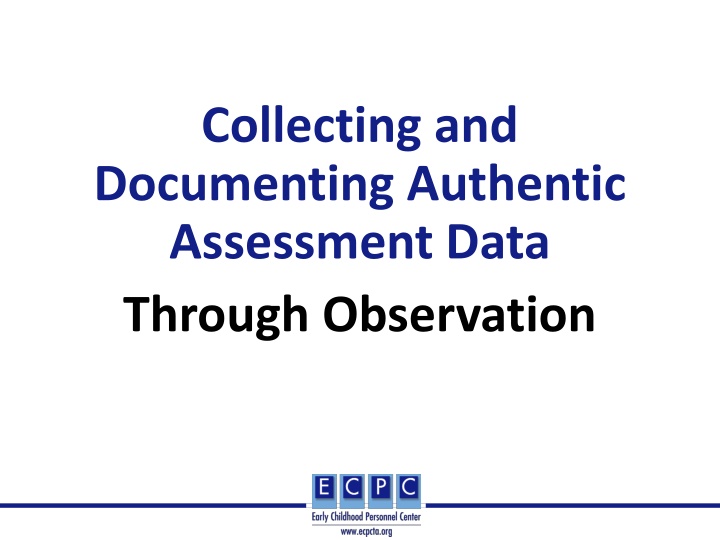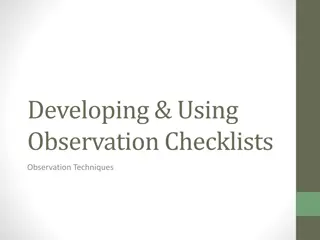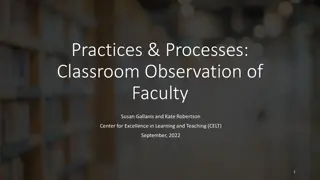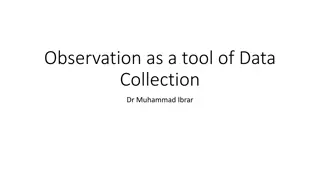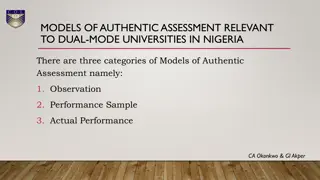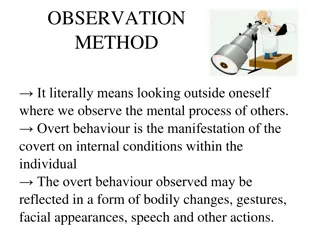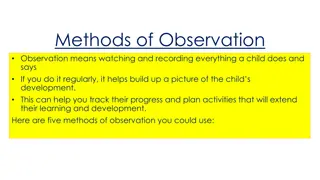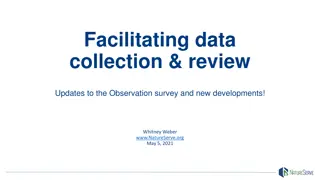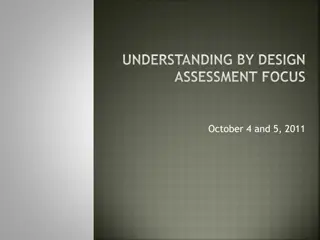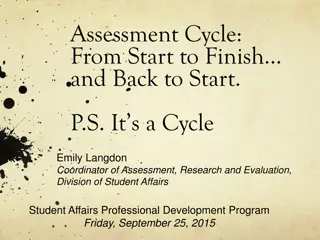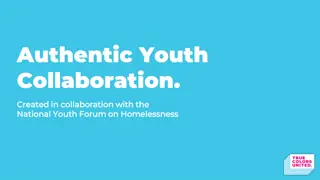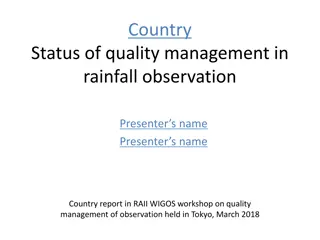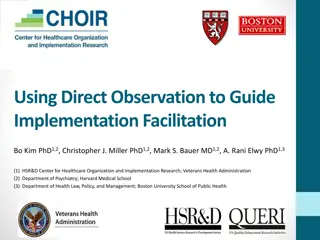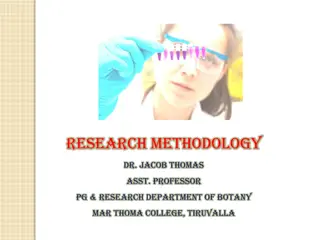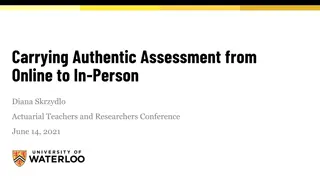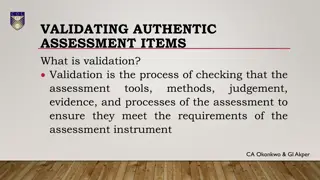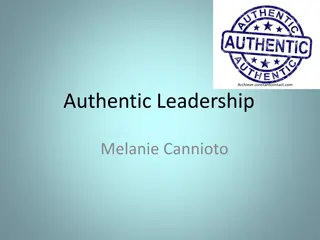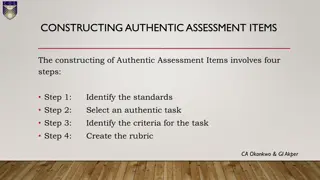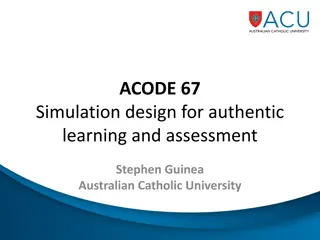Authentic Assessment through Systematic Observation: Best Practices
Explore the process of authentic assessment through systematic observation in early childhood education. Learn about collecting, documenting, and interpreting assessment data using evidence-based practices and technology. Discover the importance of working collaboratively with families and professionals, selecting appropriate assessment materials, and utilizing various assessment methods. Enhance your understanding of the Authentic Assessment Cycle and systematic observation techniques for comprehensive child evaluation.
Download Presentation

Please find below an Image/Link to download the presentation.
The content on the website is provided AS IS for your information and personal use only. It may not be sold, licensed, or shared on other websites without obtaining consent from the author.If you encounter any issues during the download, it is possible that the publisher has removed the file from their server.
You are allowed to download the files provided on this website for personal or commercial use, subject to the condition that they are used lawfully. All files are the property of their respective owners.
The content on the website is provided AS IS for your information and personal use only. It may not be sold, licensed, or shared on other websites without obtaining consent from the author.
E N D
Presentation Transcript
Collecting and Documenting Authentic Assessment Data Through Observation
EI/ECSE Standard 4, Component 4.2 Candidates develop and administer informal assessments and/or select and use valid, reliable formal assessments using evidence- based practices, including technology, in partnership with families and other professionals.
DEC Recommended Practices (RPs, 2014) A2 Practitioners work as a team with the family and other professionals to gather assessment information. A3 Practitioners use assessment materials and strategies that are appropriate for the child s age and level of development and accommodate the child s sensory, physical, communication, cultural, linguistic, social, and emotional characteristics.
DEC RPs (2014) A6 Practitioners use a variety of methods, including observation and interviews, to gather assessment information from multiple sources, including the child s family and other significant individuals in the child s life. A7 Practitioners obtain information about the child s skills in daily activities, routines, and environments such as home, center, and community.
Objectives Systematic observation as it relates to the Authentic Assessment Cycle. Describe Identify The collection and documentation of child observations used for authentic assessment. and Describe Identify and describe The use of technology in collecting and documenting observations.
Authentic Assessment Cycle Observation Intervention & Instruction Documen- tation Review & Interpreta- tion Planning
Systematic Observation Is: Regular, deliberate, and thoughtful listening, watching, and recording of a child s behavior or skill performance,. Record of exactly what the child says or does, Recorded as soon as possible, Across settings, times, and people, Unobtrusive, and Planned.
Planning for Assessment Observations (2:55) Watch the video and respond to the following questions: What is the rationale for developing weekly assessment plans? What, other than Head Start Early Learning Outcomes, might you use to determine what to assess? How can the information in the video be applied to home-based programs?
Questions to Consider in Selecting an Authentic Assessment Measure Who is to be assessed? An individual? A group? What behavior(s) or skill(s) are to be assessed? What is the best assessment measure for those behavior(s) or skill(s)? Who will conduct the assessment and when? What training is needed to use that measure? What materials, etc. are needed? How will the results be summarized, interpreted and used?
Authentic Assessment Measures Anecdotal notes Event recording Duration recording Interval recording Checklists Rubrics Portfolios
Anecdotal Notes: The What and Why Narrative account of a specific event, Brief or detailed record of the event, Observation of one or more children, Objective statement(s) of observed actions what the child is saying and/or doing, Simplest form of direct observation, and Often used to develop an understanding of a child s behavior.
Anecdotal Notes: The How Record identifying information: o Child s name o Observer o Date o Activity, setting, and/or routine o Beginning and ending time Objectively record what you see and hear. If the target child is interacting with one or more children or adult(s), record what you observe all individuals saying and doing.
Clearing Your View: Staying Objective in Observation (6:38) Watch the video and respond to the following questions: What are reasons for recording observations objectively? What are some of the things that you can record or document when observing young children to ensure objectivity? What are some things that you can do to practice recording observations objectively?
Recording Objective Statements Read each statement below and decide if it is objectively written. Rewrite those that are not objectively stated. 1. Playing peek-a-boo with Destiny, mom slowly removed her hand from her face. Destiny laughed. 2. Troy threw the crayon because he was mad. 3. Ella was crying, and she was hungry. 4. Alex rolled the truck to dad and clapped his hands.
Collecting and Using Anecdotal Records (3:56) Watch the video and respond to the following questions: What is the purpose of collecting anecdotal records? What are some of the strategies for documenting anecdotal notes in a classroom setting? How might you compile the notes for an individual child to share with caregivers and others?
Sample Anecdotal Note Child s Name: Lucia Date: 8-29 Time: 10-10:15 AM Lucia and Tamara are seated next to each other on a bean bag in the book center. Lucia holds a book about dogs. Tamara is looking at the book as Lucia turns the pages. Lucia pointed to a picture of a dog. She said, I see a dog. It is a black dog. Then Lucia turns to Tamara and says, look, it is my dog. Observer: Marcy Setting: Literacy Center
Rewrite This Anecdotal Note 11-12, 9:20 AM, Outdoor play Sebrina stood by herself watching a group of girls play a game. She wanted to ask if she could play. However, her stuttering kept her from asking to be included in the game. She was afraid the other children would laugh at her. After watching the game for 10 minutes, she walked away and sat quietly by herself until outdoor play was over.
Event Recording (Sampling): The What and Why Record of how many times a behavior occurs over a designated period of time. Useful with discrete behaviors that are short in duration. Use when want to increase or decrease behavior. Data collected over time to identify trends and/or progress. Not appropriate for high frequency behaviors.
Event Recording: The How Record the time the observation begins. Record each occurrence of the behavior. Record the time the observation ends. Determine the total length of time for the observation. Count the number of times the behavior occurred and divide by the length of the observation to determine rate.
Sample Event Recording Form Child s Name: Observer: Behavior Definition: Activity(ies): Date(s): Date Time Tally For Each Time Behavior Occurs Total Number of Times Behavior Occurred
Observe and Practice Event Recording (5:00) Watch the video of the pretend lunch Observe Bih, the child in the white shirt, for behavior of walking away from activity, Behavior definition Bih walks away from table and returns to table, Using the event recording form from the previous slide, make a tally mark each time the behavior occurs, Calculate the rate or percent of time that the behavior occurs.
Duration Recording: The What and Why The length of time that a behavior occurs within a specific observation. Used for behaviors that: oHave a clear beginning and ending, and oLast more than a few seconds and/or for varying lengths of time. Provides data about the frequency and duration of a behavior. Allows the team to see small improvements in behavior over time.
Duration Recording: The How Define the target behavior. Identify the activity(ies) in which to observe the behavior For each occurrence, note when the behavior begins. For each occurrence, note when the behavior ends. Total the number of minutes the behavior occurs during an activity and divide by the total number of minutes for that activity
Latency as a Type of Duration Recording Length of time it takes a child to begin a task once introduced. Requires a dedicated observer. Allows the team to see small improvements in behavior over time.
Sample Duration Recording Form Child s Name: Antonio Observer: Karin Dates Observed: 9-19, 9-20 Behavior: Attending to task Setting: Small group Date Activity Time Beginning Time Ending Time Duration 9-19 9:00-9:20 AM 9:05 AM 9:08 AM 3 minutes 9-19 9:00-9:20 AM 9:11 AM 9:15 AM 4 minutes 9-20 9:00-9:20 AM 9:04 AM 9:08 AM 4 minutes 9-20 9:00-9:20 AM 9:10 AM 9:14 AM 4 minutes
Observe and Practice Duration Recording (2:00) Watch the video of Jasmin and Alyssandra , Observe Alyssandra (child with long hair wearing purple shirt) for behavior of stays on task, Behavior definition Alyssandra looks at paper and stencil and marks within the stencil, Using the duration below, record the number of seconds that Alyssandra exhibits the behavior, Calculate the percent of time that Alyssandra stayed on task.
Duration Recording Form for Alyssandra Child s Name: Observer: Dates Observed: Setting: Behavior: Date Activity Time Duration 2 minutes 2 minutes 2 minutes 2 minutes 2 minutes 2 minutes 2 minutes
Interval Recording: Three Types Whole The behavior is continuous throughout the interval. Partial The behavior occurs sometime during the interval. Momentary The behavior occurs at the end of the interval.
Whole Interval Recording: The What and Why Observation of whether a behavior occurs or does not occur during a specified time period, Time period divided into equal intervals, Documentation of behavior if occurs during entire interval, Used for behavior not easily counted. Provides an estimate of the duration of behavior and where behavior occurs in an observational session.
Partial Interval Recording: The What and Why Observation of whether a behavior occurs or does not occur during a specified time period, Time period divided into equal intervals, Documentation if behavior occurs any time during interval, not likely to occur for entire interval, Used for behaviors not easily counted or those that happen so quickly difficult to record with other methods, Provides an estimate of frequency, duration, and where behavior occurs across observations.
Momentary Time Sampling: The What and Why Observation of whether a behavior occurs or does not occur during a specified time period, Time period divided into equal intervals, Documentation if behavior occurs at the end of the interval, May underestimate the occurrence of a behavior, Most useful to record behaviors that are more frequent and last longer periods of time.
Interval Recording: The How Define the target behavior. Identify the activity(ies) in which to observe the behavior Divide the time period into equal intervals. Determine which type of interval recording to use: oWhole record if behavior occurs in entire interval, oPartial record if behavior occurs anytime in interval, oMomentary record if behavior occurs at end of interval. Total the number of intervals in which the behavior occurs divide by the total number of intervals to obtain a percentage.
Sample Interval Recording Form Child s Name: Dates: Setting or Activity: Circle one Whole, Partial, or Momentary Interval Date Interval Behavior Occurrences (+ or -) Observer: Behavior: Comments
Observe and Practice Interval Recording (1:44) Watch the video of Gabby and Nicholas Observe Gabby for behavior of touching another child in 20 second intervals, Behavior definition Gabby touches another child with one or more parts of her body, Using the interval recording form from the previous slide, record a + if the behavior occurs any time during the interval.
Interval Recording Form for Gabby Child s Name: Dates: Setting or Activity: Circle one Whole, Partial, or Momentary Interval Observer: Behavior: Date Interval Behavior Comments Occurrences (+ or -)
Checklists: The What and Why List of specific skills or behaviors arranged in a logical order. Used to record the presence or absence of that skill or behavior. Can be designed to assess progress toward mastering a skill or behavior.
Using Checklists (4:55) Watch the video and respond to the following questions: What are benefits for using checklists in an early childhood setting? How is the content and format of checklists determined? How can checklists be used in a home-based setting?
Checklists Advantages and Disadvantages Advantages Disadvantages Lack of detailed information, Only specific behaviors or skills are noted, Requires time for developing. Quickly recorded, Easy to use, Can measure progress toward a goal/outcome, Can use for one child or a group of children. Recorded information easily summarized.
Learning Activity: Classroom Scenario Read the activity overview at this link and follow the directions for designing a sample checklist. Source: Head Start Early Childhood Learning and Knowledge Center. (n.d.). Ongoing Child Assessment. Head Start Early Childhood Learning and Knowledge Center. Ongoing Child Assessment | ECLKC (hhs.gov)
Rubrics A set of scoring guidelines for evaluating a child s performance Rubrics answer these questions: oWhat criteria should be used to measure the performance? o What does the range in quality of performance look like? oHow should the different levels of quality be described and distinguished from one another?
Rubrics Include: Components of the task, Key criteria to be assessed, and Descriptors for each level of performance to enable reliable scoring.
Sample Rubric for Drawing a Square Criteria Emerging Satisfactory Excellent Draws four equal length lines Draws four different length lines Draws four lines of relatively equal length Draws four lines of equal length Connects lines at right angles Two of the four lines connected at right angles Three of the four lines connected at right angles with some space between fourth angle All four lines connected at right angles
Portfolios: The What and Why A collection of a child s work that accurately demonstrates effort and progress over time. Documentation of an individual child s progress not for comparison with other children. Supports the educator s interpretations of progress. When reviewed by others, similar conclusions reached about the child s progress.
Examples of Portfolio Items Children work samples: oArtwork and/or descriptions of artwork, oDictated stories, oPhotos of child s work and/or participation in an activity, oVideos of child s participation in activities oProducts representing understanding of concepts, oWriting samples, Anecdotal notes, Summarized data from observations.
Collecting and Using Work Samples (4:58) Watch the video and respond to the following questions: What factors should be considered in collecting work samples for an individual child? What are some strategies for organizing the work sample? How can work sample content be summarized and shared?
Selecting and Interpreting Work Samples Complete the activity at this link, Selecting Work Samples to Inform Teaching, Then, for each photo and drawing, respond to the following questions: oWhat does each photo/drawing tell you about the child s current development/performance? oHow might you summarize this information to share with others? Source: Head Start Early Childhood Learning and Knowledge Center. (n.d.). Ongoing Child Assessment. Head Start Early Childhood Learning and Knowledge Center. Ongoing Child Assessment | ECLKC (hhs.gov)
Portfolios: The How Portfolios are typically organized: In a binder/notebook or an electronic file, By specific time periods, By content areas (e.g., literacy, math, art) and/or, developmental domains, and In sequence from earliest to most recent work samples, observation summaries, etc.
Using the Portfolio to Communicate with Families A means for information sharing in parent-teacher conferences and home visits, Provides for concrete examples of the child s work in discussing progress, What to discuss: oA continuum of work samples with background information, oSummaries, graphs, etc. from observations, and oSuggestions for activities at home.
Sharing Video Documentation with Families (2:47) Watch the video and respond to the following questions: What skills does this teacher identify as most relevant for video documentation? What other skills might best be videotaped to communicate progress with families. How might you share video clips with families and other team members?
Activity: Authentic Assessment Plan Identify an IFSP outcome or IEP goal for a child with whom you are currently working or observing and develop an authentic assessment plan using one or more of the methods discussed. The plan should include: What to assess List the specific skills to be assessed. How to assess Select the method(s) from those discussed and how the data will be organized and summarized. When to assess Who will assess
